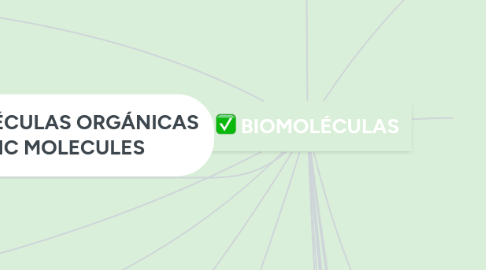
1. En los organismos se encuentran 4 tipos diferentes de MOLÉCULAS orgánicas en gran cantidad: In organisms there are 4 different types of organic MOLECULES in large quantities:
2. 1. CARBOHIDRATOS: Son la principal fuente de energía del cuerpo; son ricos en carbono, glúcidos, azucares o sacáridos. 1. CARBOHYDRATES: They are the main source of energy of the body; They are rich in carbon, carbohydrates, sugars or saccharides.
3. ESTRUCTURA - STRUCTURE
3.1. CARBONO, HIDROGENO, OXIGENO, NITRÓGENO /// CARBON, HYDROGEN, OXYGEN, NITROGEN
3.1.1. PRIMERAS CÉLULAS ORGÁNICAS FIRST ORGANIC CELLS
3.1.1.1. NUTRIENTES NUTRIENTS
3.1.1.1.1. MACRONUTRIENTES MACERONUTRIENTS
4. CLASIFICACIÓN DE LAS MOLÉCULAS ORGÁNICAS /CLASSIFICATION OF ORGANIC MOLECULES
5. 2. LIPIDOS: Cumplen funciones diversas en los organismos vivientes, entre ellas la de la reserva energética (como los triglicéridos), la estructural (como los fosfolípidos de las bicapas) y la reguladora (como las hormonas esteroides). 2. LIPIDS: They fulfill diverse functions in living organisms, among them the energy reserve (such as triglycerides), the structural one (such as bilayer phospholipids) and the regulatory one (such as steroid hormones)
6. 3. PROTEÍNA: determinan la forma y la estructura de las células y dirigen casi todos los procesos vitales. Las funciones de las proteínas son específicas de cada una de ella y permite a las células mantener su integridad, defenderse de agentes externos, reparar daños, controlar y regular funciones etc. 3. PROTEIN: determine the shape and structure of cells and direct almost all vital processes. Protein functions are specific to each one of them and allow cells to maintain their integrity, defend against external agents, repair damage, control and regulate functions etc
7. 4. NUCLEIDO: es un compuesto químico muy fundamental de los ácidos nucleicos, constituido por una base nitrogenada, un azúcar y una molécula de ácido fosfórico. Poseen un gran interés biológico, ya que, además de construir los ácidos nucleicos (función estructural), llevan a cabo unas funciones básicas cuando se encuentran libres en la celula. 4. NUCLEIDO: is a very fundamental chemical compound of nucleic acids, consisting of a nitrogen base, a sugar and a phosphoric acid molecule. They have a great biological interest, since, in addition to building nucleic acids (structural function), they perform basic functions when they are free in the cell.
8. PESCADO, LECHE, HUEVOS LEGUMBRES/FISH, MILK, VEGETABLE EGGS
9. PROTEÍNAS: AMINOÁCIDOS, (C+H+O+N) / PROTEINS: AMINO ACIDS, (C + H + O + N)
10. Una biomolécula es un compuesto químico que se encuentra en los organismos vivos. Están formadas por sustancias químicas compuestas principalmente por carbono, hidrógeno, oxígeno, nitrógeno, sulfuro y fósforo. A biomolecule is a chemical compound found in living organisms. They consist of chemical substances composed mainly of carbon, hydrogen, oxygen, nitrogen, sulfur and phosphorus.
11. CARBOHIDRATOS (HIDRATOS DE CARBONO) C+H+O
11.1. MONOSACARIDOS
11.1.1. FRUCTOSA Y LACTOSA / FRUCTOSE AND LACTOSE
11.2. DISACARIDOS
11.2.1. SACAROSA, MALTOSA Y LACTOSA /SACAROSE, MALTOSE AND LACTOSE
11.3. POLISACARIDOS
11.3.1. ALMIDÓN - GLICÓGENO - CELULOSA - QUITINA - GLUCOPROTEINAS ALMIDÓN - GLUCÓGENO - CELLULOSE - QUITINA - GLUCOPROTEINAS
12. ACEITE DE OLIVA, AGUACATE / OLIVE OIL, AVOCADO
13. GRASAS, ACEITES ANIMALES Y VEGETALES / FATS, ANIMAL AND VEGETABLE OILS
14. LÍPIDOS: (C+H-+O) / LIPIDS: (C + H- + O)
15. DEFINICIÓN-DEFINITION
16. IMPORTANCIA PARA LOS SERES VIVOS / IMPORTANCE FOR LIVING BEINGS
17. FUNCIÓN BIOLÓGICA BIOLOGICAL FUNCTION
17.1. CARBOHIDRATOS CARBOHYDRATES
17.1.1. FUNCIÓN DE RESERVA ENERGÉTICA ENERGY RESERVE FUNCTION
17.1.2. FUNCIÓN PREBIÓTICA PREBIOTIC FUNCTION
17.1.3. FUNCIÓN DE RESERVA RESERVATION FUNCTION
17.2. LIPIDOS / LIPIDS
17.2.1. FUNCIÓN DE RESERVA RESERVATION FUNCTION
17.2.2. FUNCIÓN ESTRUCTURAL STRUCTURAL FUNCTION
17.2.3. FUNCIÓN BIOCATALIZADORA BIOCATALIZING FUNCTION
17.2.4. FUNCIÓN TRANSPORTADORA CONVEYOR FUNCTION
17.3. VITAMINAS Y MINERALES VITAMINS AND MINERALS
17.3.1. MANTIENE SANA LA PIEL KEEP SKIN HEALTHY
17.3.2. SON LA PRINCIPAL FUENTE DE DEFENSAS THEY ARE THE MAIN SOURCE OF DEFENSES
17.4. GRASAS / FATS
17.4.1. OTRA FUNCIÓN DE RESERVA ANOTHER RESERVATION FUNCTION
17.4.2. SUJETAN Y PROTEGEN ÓRGANOS INTERNOS SUBJECT AND PROTECT INTERNAL ORGANS
17.4.3. PRECURSORAS DE ALGUNAS SUSTANCIAS PRECURSORS OF SOME SUBSTANCES
17.4.4. FORMAN PARTE DE LAS MEMBRANAS DE TODAS LAS CÉLULAS THEY ARE PART OF THE MEMBRANES OF ALL CELLS
